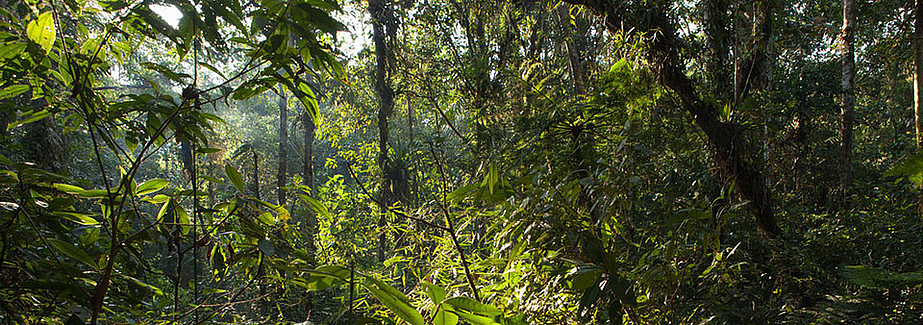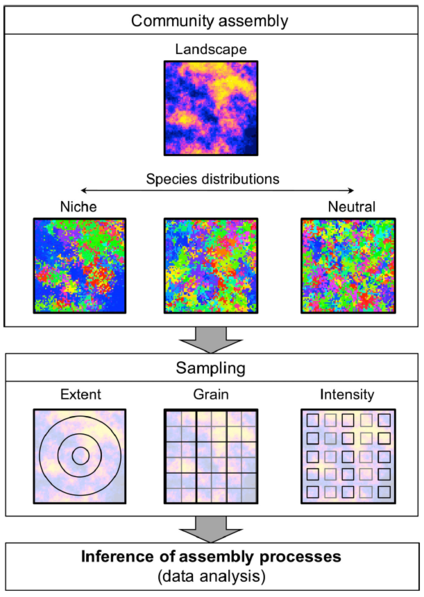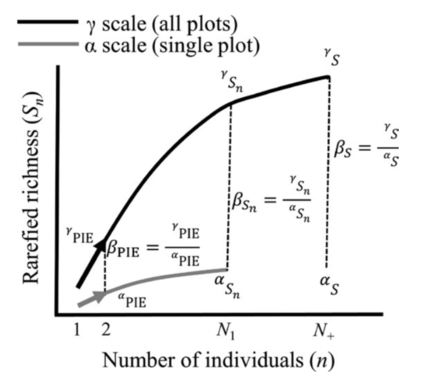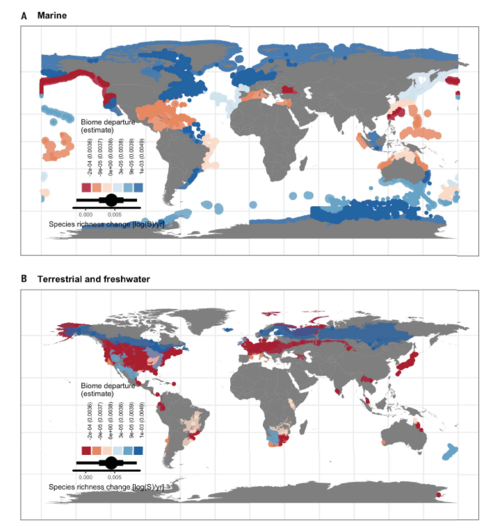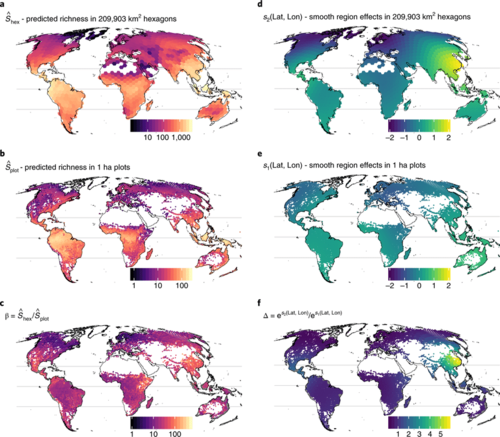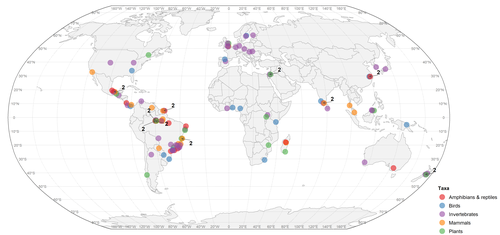Research areas
We are developing overarching conceptual and theoretical principles, as well as new analytical tools for understanding the patterns of biodiversity and its heterogeneous distribution across multiple scales, and the underlying ecological drivers that influence those patterns.
Metacommunity Ecology
We aim at disentangling the different processes underlying community assembly and metacommunity dynamics. To this end, we are currently moving beyond classical approaches by integrating crucial dimensions such as spatial scale and time, as well as using and/or developing state-of-the-art analytical tools that allow us to infer assembly processes from measured biodiversity patterns.
Representative publications
May, F., Wiegand, T., Huth, A., Chase, J. M. (2020): Scale-dependent effects of conspecific negative density dependence and immigration on biodiversity maintenance. Oikos.
Viana, D. S., Chase, J. M. (2019): Spatial scale modulates the inference of metacommunity assembly processes. Ecology 100(2), e02576.
Shoemaker, L. G., Sullivan, L. L., Donohue, I., Cabral, J. S., ...., Chase, J. M., Chu, C., Harpole, W. S., Huth, A., ..., May, F., ..., Wiegand, T., Yang, Q., Abbott, K. C. (2019): Integrating the underlying structure of stochasticity into community ecology. Ecology 101(2).
Leibold, M. A., Chase, J. M. (2018): Metacommunity Ecology. In: (Eds.) Princeton University Press, Princeton, Oxford.
Measures of Biodiversity
Our aim is to use biodiversity metrics that, unlike traditional measures of biodiversity (richness and Shannon diversity), are unbiased by sample size and thus allow us to disentangle factors that determine biodiversity at any given place, time and scale. We use metrics derived from the individual rarefaction curve that capture the components of biodiversity we are most interested in, namely:
– The Species Abundance Distribution (SAD)
– Number of individuals (density effects)
– Aggregation (clumping) of conspecific individuals
The metrics we use are: N - Number of individuals, S - Observed species richness, Sn - Rarefied species richness, PIE - Probability of Interspecific Encounter (Hurlbert 1971), SPIE - Effective Number of Species conversion of the PIE (Jost 2007).
Representative publications
McGlinn, D. J., Xiao, X., May, F., Gotelli, N. J., Engel, T., Blowes, S. A., Knight, T. M., Purschke, O., Chase, J. M., McGill, B. J. (2019): Measurement of Biodiversity (MoB): A method to separate the scale-dependent effects of species abundance distribution, density, and aggregation on diversity change. Methods in Ecology and Evolution 10(2), 258-69.
Chase, J. M., McGill, B. J., McGlinn, D. J., May, F., Blowes, S. A., Xiao, X., Knight, T. M., Purschke, O., Gotelli, N. J. (2018): Embracing scale-dependence to achieve a deeper understanding of biodiversity and its change across communities. Ecology Letters 21(11), 1737-51.
May, F., Gerstner, K., McGlinn, D. J., Xiao, X., Chase, J. M. (2018): mobsim: An R package for the simulation and measurement of biodiversity across spatial scales. Methods in Ecology and Evolution 9(6), 1401-08.
Biodiversity Change
We are interested in quantifying biodiversity change across space and through time. In addition to our work quantifying classical macro- and biogeographical patterns, we are also involved in analyses of global databases of time-series (e.g., BioTIME). We make unbiased measures of all components of biodiversity in a scale-sensitive manner to provide robust estimates of how and where biodiversity is changing across the globe.
Representative publications
Blowes, S. A., Chase, J. M., Di Franco, A., Frid, O., Gotelli, N. J., Guidetti, P., Knight, T. M., May, F., McGlinn, D. J., Micheli, F., Sala, E., Belmaker, J.(2020): Mediterranean marine protected areas have higher biodiversity via increased evenness, not abundance. Journal of Applied Ecology (in press).
van Klink, R., Bowler, D. E., Gongalsky, K. B., Swengel, A. B., Gentile, A., Chase, J. M. (2020): Meta-analysis reveals declines in terrestrial but increases in freshwater insect abundances. Science 368(6489), 417-420.
Blowes, S. A., Supp, S. R., Antão, L. H., Bates, A., Bruelheide, H., Chase, J. M., ..., Winter, M., Bjorkman, A. D., Bowler, D. E., ..., Hines, J., Isbell, F., Jones, H. P., Navarro, L. M. et al. (2019): The geography of biodiversity change in marine and terrestrial assemblages. Science 366(6463), 339-345.
Chase, J. M., McGill, B. J., Thompson, P. L., Antão, L. H., Bates, A. E., Blowes, S. A., Dornelas, M., Gonzalez, A., Magurran, A. E., Supp, S. R., Winter, M., Bjorkman, A. D., Bruelheide, H., Byrnes, J. E. K., Cabral, J. S., Elahi, R., Gomez, C., Guzman, H. M., Isbell, F., Myers-Smith, I. H., Jones, H. P., Hines, J., Vellend, M., Waldock, C., O'Connor, M. (2019): Species richness change across spatial scales.Oikos 128(8), 107-109.
Horváth, Z., Ptacnik, R., Vad, C. F., Chase, J. M. (2019): Habitat loss over six decades accelerates regional and local biodiversity loss via changing landscape connectance. Ecology Letters 22(6), 1019-27.
May, F., Rosenbaum, B., Schurr, F. M., Chase, J. M. (2019): The geometry of habitat fragmentation: Effects of species distribution patterns on extinction risk due to habitat conversion. Ecology and Evolution 9(5), 2775-90.
Hillebrand, H., Blasius, B., Borer, E. T., Chase, J. M., Downing, J., Eriksson, B. K., Filstrup, C. T., Harpole, W. S., Hodapp, D., Larsen, S., et al. (2018): Biodiversity change is uncoupled from species richness trends: consequences for conservation and monitoring. Journal of Applied Ecology 55(1), 169-84.
Keil, P., Pereira, H. M., Cabral, J. S., Chase, J. M., May, F., Martins, I. S., Winter, M. (2018): Spatial scaling of extinction rates: Theory and data reveal nonlinearity and a major upscaling and downscaling challenge. Global Ecology and Biogeography 27(1), 2-13.
Macroecology and Biodiversity Patterns
We study broad-scale variation of biodiversity on Earth, focusing on multiple taxa such as trees, ants, coral reef fishes, birds, or mammals. We document and explain patterns that include the latitudinal gradient of diversity, species-area relationships, species-energy relationships, or imprints of historical processes in the geographic distribution of biodiversity.
Representative publications
Chase, J. M., Gooriah, L., May, F., Ryberg, W. A, Schuler, M. S, Craven, D., & Knight, T. M. (2019). A framework for disentangling ecological mechanisms underlying the island species–area relationship. Frontiers of Biogeography 11(1).
Craven, D., Knight,T. M., Barton, K. E., Bialic-Murphy, L., Chase, J. M. (2019): Dissecting macroecological and macroevolutionary patterns of forest biodiversity across the Hawaiian archipelago. Proceedings of the National Academy of Sciences 116(33), 16436-16441.
Gooriah, L. D., Chase, J. M (2019): Sampling effects drive the species–area relationship in lake zooplankton. Oikos 129(1), 124-132.
Keil, P., Chase, J. M. (2019): Global patterns and drivers of tree diversity integrated across a continuum of spatial grains. Nature Ecology & Evolution 3, 390-99.
McGill, B. J., Chase, J. M., et al. (2019): Unifying macroecology and macroevolution to answer fundamental questions about biodiversity. Global Ecology and Biogeography 28(12), 1925-1936.
Shade, A., Dunn, R. R., Blowes, S. A., Keil, P., Bohannan, B. J. M., Herrmann, M., Küsel, K., Lennon, J. T., Sanders, N. J., Storch, D., Chase, J. M. (2018): Macroecology to Unite All Life, Large and Small. Trends in Ecology & Evolution 33(10), 731-44.
Blowes, S. A., Belmaker, J., Chase, J. M. (2017): Global reef fish richness gradients emerge from divergent and scale-dependent component changes. Proceedings of the Royal Society B: Biological Sciences 284(1867).
Community Assembly and Ecosystem Functioning (CAFE)
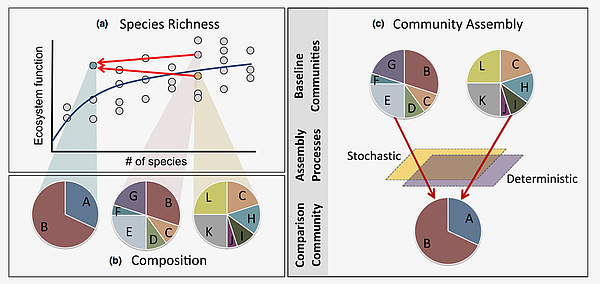
We explicitly investigate the entire set of community assembly processes that might affect the functioning of ecosystems. This includes the classical relationship with biodiversity (Biodiversity-Ecosystem-Function (BEF) relationship), but also uniquely focuses on the identity and composition of species as well as the processes that determine which species compose a community. We build on recent analytical advances and tools, including Structural Equation Modelling (SEM) and prioritization, to investigate how changes in species richness and composition driven by environmental change affect ecosystem function, to help develop the next generation of ecosystem-biodiversity interaction studies.
Bannar-Martin, K. H., Kremer, C. T., Ernest, M., Leibold, M. A., Auge, H., Chase, J., Declerck, S. A. J., Eisenhauer, N., Harpole, S., Hillebrand, H., Isbell, F., Koffel, T., Larsen, S., Narwani, A., Petermann, J. S., Roscher, C., Cabral, J. S., Supp, S. R. (2018): Integrating community assembly and biodiversity to better understand ecosystem function: the Community Assembly and the Functioning of Ecosystems (CAFE) approach. Ecology Letters 21(2), 167-80.
Leibold, M. A., Chase, J. M., Ernest, S. K. M. (2017): Community Assembly and the Functioning of Ecosystems: How Metacommunity Processes Alter Ecosystems Attributes. Ecology 98(4), 909-19.
Synthesis, Meta-Analyses, Data Integration
We develop syntheses on biodiversity, from species distributions to community patterns and biodiversity metrics, across taxonomic, functional and phylogenetic levels. Ultimately, we aim to unify ecological theories and better understand the processes underlying species diversity and coexistence across different trophic levels, ecosystems, realms, and spatial scales. For that purpose, we build large-scale databases and develop conceptual and analytical frameworks to integrate across multiple sources of data and test general ecological hypotheses.
Representative publications
Jeliazkov, A., Mijatovic, D., ..., Klink, R. v., Villéger, S., Wegman, R., Westgate, M. J., Wolff, J., Żarnowiec, J., Zolotarev, M., Chase, J. M. (2020): A global database for metacommunity ecology, integrating species, traits, environment and space. Scientific Data 7(1).
Chase, J. M., Liebergesell, M., Sagouis, A., May, F., Blowes, S. A., et al. (2019): FragSAD: A database of diversity and species abundance distributions from habitat fragments. Ecology 100(12) e02861.
Craven, D., Knight, T. M., Barton, K. E., Bialic-Murphy, L., Cordell, S., Giardina, C. P., Gillespie, T. W., Ostertag, R., Sack, L., Chase, J. M. (2018): OpenNahele: the open Hawaiian forest plot database. Biodiversity Data Journal 6(e28406).
